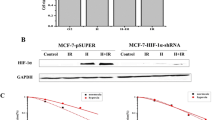Summary
Reduced radiosensitivity of lung cancer cells represents a pivotal obstacle in clinical oncology. The hypoxia-inducible factor (HIF)-1α plays a crucial role in radiosensitivity, but the detailed mechanisms remain elusive. A relationship has been suggested to exist between hypoxia and autophagy recently. In the current study, we studied the effect of hypoxia-induced autophagy on radioresistance in lung cancer cell lines. A549 and H1299 cells were cultured under normoxia or hypoxia, followed by irradiation at dosage ranging from 0 to 8 Gy. Clonogenic assay was performed to calculate surviving fraction. EGFP-LC3 plasmid was stably transfected into cells to monitor autophagic processes. Western blotting was used to evaluate the protein expression levels of HIF-1α, c-Jun, phosphorylated c-Jun, Beclin 1, LC3 and p62. The mRNA levels of Beclin 1 were detected by qRT-PCR. We found that under hypoxia, both A549 and H1299 cells were radio-resistant compared with normoxia. Hypoxia-induced elevated HIF-1α protein expression preferentially triggered autophagy, accompanied by LC3 induction, EGFP-LC3 puncta and p62 degradation. In the meantime, HIF-1α increased downstream c-Jun phosphorylation, which in turn upregulated Beclin 1 mRNA and protein expression. The upregulation of Beclin 1 expression, instead of HIF-1α, could be blocked by SP600125 (a specific inhibitor of c-Jun NH2-terminal kinase), followed by suppression of autophagy. Under hypoxia, combined treatment of irradiation and chloroquine (a potent autophagy inhibitor) significantly decreased the survival potential of lung cancer cells in vitro and in vivo. In conclusion, hypoxia-induced autophagy through evaluating Beclin1 expression may be considered as a target to reverse the radioresistance in cancer cells.
Similar content being viewed by others
References
Graves EE, Vilalta M, Cecic IK, et al. Hypoxia in models of lung cancer: implications for targeted therapeutics. Clin Cancer Res, 2010, 16(19):4843–4852
Semenza GL. HIF-1 mediates metabolic responses to intratumoral hypoxia and oncogenic mutations. J Clin Invest, 2013, 123(9):3664–3671
Liu XW, Su Y, Zhu H, et al. HIF-1α-dependent autophagy protects HeLa cells from fenretinide (4-HPR)-induced apoptosis in hypoxia. Pharmacol Res, 2010, 62(5):416–425
Yoshiba S, Ito D, Nagumo T, et al. Hypoxia induces resistance to 5-fluorouracil in oral cancer cells via G(1) phase cell cycle arrest. Oral Oncol, 2009, 45(2):109–115
Song X, Liu X, Chi W, et al. Hypoxia-induced resistance to cisplatin and doxorubicin in non-small cell lung cancer is inhibited by silencing of HIF-1alpha gene. Cancer Chemother Pharmacol, 2006, 58(6):776–784
Dayan F, Roux D, Brahimi-Horn MC, et al. The oxygen sensor factor-inhibiting hypoxia-inducible factor-1 controls expression of distinct genes through the bifunctional transcriptional character of hypoxia-inducible factor-1alpha. Cancer Res, 2006, 66(7):3688–3698
Koh MY, Powis G. HAF: the new player in oxygenindependent HIF-1alpha degradation. Cell Cycle, 2009, 8(9): 1359–1366
Pietrocola F, Izzo V, Niso-Santano M, et al. Regulation of autophagy by stress-responsive transcription factors. Semin Cancer Biol, 2013, 23(5):310–322
Maiuri MC, Zalckvar E, Kimchi A, et al. Self-eating and self-killing: crosstalk between autophagy and apoptosis. Nat Rev Mol Cell Biol, 2007, 8(9):741–752
Bellot G, Garcia-Medina R, Gounon P, et al. Hypoxiainduced autophagy is mediated through hypoxia-inducible factor induction of BNIP3 and BNIP3L via their BH3 domains. Mol Cell Biol, 2009, 29(10):2570–2781
Li DD, Wang LL, Deng R, et al. The pivotal role of c-Jun NH2-terminal kinase-mediated Beclin 1 expression during anticancer agents-induced autophagy in cancer cells. Oncogene, 2009, 28(6):886–898
Martinez-Outschoorn U, Sotgia F, Lisanti MP. Tumor microenvironment and metabolic synergy in breast cancers: critical importance of mitochondrial fuels and function. Semin Oncol, 2014, 41(2):195–216
Thomlinson RH, Gray LH. The histological structure of some human lung cancers and the possible implications for radiotherapy. Br J Cancer, 1955, 9(4):539–549
Brown JM, Wilson WR. Exploiting tumour hypoxia in cancer treatment. Nat Rev Cancer, 2004, 4(6):437–447
Ye J, Wu D, Wu P, et al. The cancer stem cell niche: cross talk between cancer stem cells and their microenvironment. Tumour Biol, 2014, 35(5):3945–3951
Lee JM, Bernstein A. p53 mutations increase resistance to ionizing radiation. Proc Natl Acad Sci USA, 1993, 90(12):5742–5746
Mazure NM, Pouyssegur J. Hypoxia-induced autophagy: cell death or cell survival? Curr Opin Cell Biol, 2010, 22(2):177–180
Kroemer G, Marino G, Levine B. Autophagy and the integrated stress response. Mol Cell, 2010, 40(2):280–293
Moeller BJ, Cao Y, Li CY, et al. Radiation activates HIF-1 to regulate vascular radiosensitivity in tumors: role of reoxygenation, free radicals, and stress granules. Cancer Cell, 2004, 5(5):429–441
Harada H, Itasaka S, Kizaka-Kondoh S, et al. The Akt/mTOR pathway assures the synthesis of HIF-1alpha protein in a glucose- and reoxygenation-dependent manner in irradiated tumors. J Biol Chem, 2009, 284(8):5332–5342
Piccolo S, Enzo E, Montagner M. p63, Sharp1, and HIFs: master regulators of metastasis in triple-negative breast cancer. Cancer Res, 2013, 73(16):4978–4981
Michiels C, Minet E, Michel G, et al. HIF-1 and AP-1 cooperate to increase gene expression in hypoxia: role of MAP kinases. IUBMB Life, 2001, 52(1–2):49–53
Yamashita K, Discher DJ, Hu J, et al. Molecular regulation of the endothelin-1 gene by hypoxia. Contributions of hypoxia-inducible factor-1, activator protein-1, GATA-2, AND p300/CBP. J Biol Chem, 2001, 276(16):126 45–12 653
Gerald D, Berra E, Frapart YM, et al. JunD reduces tumor angiogenesis by protecting cells from oxidative stress. Cell, 2004, 118(6):781–794
Loos B, Engelbrecht AM, Lockshin RA, et al. The variability of autophagy and cell death susceptibility: Unanswered questions. Autophagy, 2013, 9(9):1270–1285
Author information
Authors and Affiliations
Corresponding author
Additional information
This project was supported by the National Natural Science Foundation of China (No. 81201779).
Rights and permissions
About this article
Cite this article
Zou, Ym., Hu, Gy., Zhao, Xq. et al. Hypoxia-induced autophagy contributes to radioresistance via c-Jun-mediated Beclin1 expression in lung cancer cells. J. Huazhong Univ. Sci. Technol. [Med. Sci.] 34, 761–767 (2014). https://doi.org/10.1007/s11596-014-1349-2
Received:
Revised:
Published:
Issue Date:
DOI: https://doi.org/10.1007/s11596-014-1349-2




